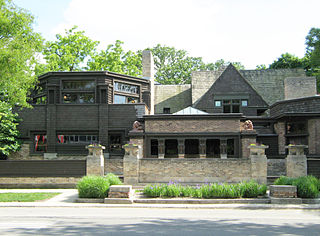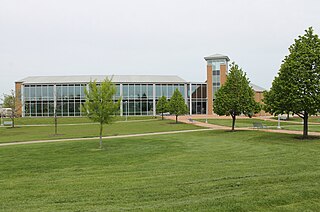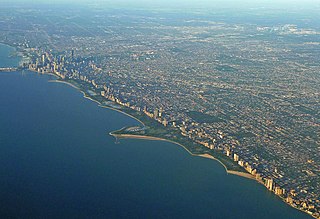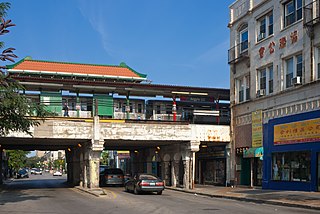
Springfield is the capital city of the U.S. state of Illinois and the seat of Sangamon County. The city's population was 114,394 at the 2020 census, which makes it the state's seventh-most populous city, the second-most populous outside of the Chicago metropolitan area, and the most populous in Central Illinois. Approximately 208,000 residents live in the Springfield metropolitan area, which consists of all of Sangamon and Menard counties. Springfield lies in a plain near the Sangamon River north of Lake Springfield. The city is on historic Route 66.

Cook County is the most populous county in the U.S. state of Illinois and the second-most-populous county in the United States, after Los Angeles County, California. More than 40 percent of all residents of Illinois live within Cook County. As of 2020, the population was 5,275,541. The county seat is Chicago, the most populous city in Illinois and the third most populous city in the United States. The county is at the center of the Chicago metropolitan area.

Matteson is a village in Cook County, Illinois, United States. The population was 19,073 at the 2020 census. It is a suburb of Chicago.

Batavia is a city mainly in Kane County and partly in DuPage County in the U.S. state of Illinois. Located in the Chicago metropolitan area, it was founded in 1833 and is the oldest city in Kane County. Per the 2020 census, the population was 26,098.

Hyde Park is a neighborhood on the South Side of Chicago, Illinois, located on and near the shore of Lake Michigan 7 miles (11 km) south of the Loop. It is one of the city's 77 community areas.

Lakeview is one of the 77 community areas of Chicago, Illinois. Lakeview is located on the city's North Side and is bordered by West Diversey Parkway on the south, West Irving Park Road on the north, North Ravenswood Avenue on the west, and the shore of Lake Michigan on the east. The Uptown community area is to Lakeview's north, Lincoln Square to its northwest, North Center to its west, and Lincoln Park to its south. The 2020 population of Lakeview was 103,050 residents, making it the second-largest Chicago community area by population.

Lincoln Square on the North Side of Chicago, Illinois, is one of the city's 77 community areas. It encompasses the smaller neighborhoods of Ravenswood, Ravenswood Gardens, Bowmanville, Budlong Woods, as well as Lincoln Square itself.

Edgewater is a lakefront community area on the North Side of the city of Chicago, Illinois six miles north of the Loop. The most recently established of the city's 77 official community areas, Edgewater is bounded by Foster Avenue on the south, Devon Avenue on the north, Ravenswood Avenue on the west, and Lake Michigan on the east. Edgewater contains several beaches for residents to enjoy. Chicago's largest park, Lincoln Park, stretches south from Edgewater for seven miles along the waterfront, almost to downtown. Until 1980, Edgewater was part of Uptown, and historically it constituted the northeastern corner of Lake View Township, an independent suburb annexed by the city of Chicago in 1889. Today, Uptown is to Edgewater's south, Lincoln Square to its west, West Ridge to its northwest and Rogers Park to its north.

The Chicago Public Library (CPL) is the public library system that serves the City of Chicago in the U.S. state of Illinois. It consists of 81 locations, including a central library, three regional libraries, and branches distributed throughout the city's 77 Community Areas. CPL was founded in 1872, in the wake of the Great Chicago Fire.

Lincoln Park is a 1,208-acre (489-hectare) park along Lake Michigan on the North Side of Chicago, Illinois. Named after US President Abraham Lincoln, it is the city's largest public park and stretches for seven miles (11 km) from Grand Avenue, on the south, to near Ardmore Avenue on the north, just north of the DuSable Lake Shore Drive terminus at Hollywood Avenue. Two museums and a zoo are located in the oldest part of the park between North Avenue and Diversey Parkway in the eponymous neighborhood. Further to the north, the park is characterized by parkland, beaches, recreational areas, nature reserves, and harbors. To the south, there is a more narrow strip of beaches east of Lake Shore Drive, almost to downtown. With 20 million visitors per year, Lincoln Park is the second-most-visited city park in the United States, behind Manhattan's Central Park.

Gene Schulter was alderman of the 47th ward of the City of Chicago. He was first elected in 1975 and served until his retirement in 2011.

Ravenswood is a neighborhood located on the North Side of the city of Chicago, Illinois. Lacking designation as one of Chicago's 77 well-defined community areas, it is mostly situated in the Lincoln Square community area, with the portion east of Ravenswood Avenue and the Chicago & Northwestern/Union Pacific North Line railroad tracks being situated in the Uptown community area.

Evanston Township was a civil township in Cook County, Illinois, United States from 1857 until 2014, when it was dissolved. At the time it was dissolved, its boundaries were coterminous with the city of Evanston, and the population at the 2010 census was 74,486.

West Argyle Street Historic District is a historic district in northern Uptown, Chicago, Illinois. It was listed on the National Register of Historic Places on June 3, 2010. The community covers an area of about 41 acres (0.17 km2); its rough boundaries are N. Glenwood Ave to the west, Winona Street to the north, Sheridan Road to the east, and Ainslie Street to the south.
Thomas H. Beeby is an American architect who was a member of the "Chicago Seven" architects and has been Chairman Emeritus of Hammond, Beeby, Rupert, Ainge Architects (HBRA) for over thirty-nine years.

The Davis Theater, originally known as the Pershing Theater, is a first run movie theater located in the Lincoln Square neighborhood of Chicago. Built in 1918, the theater has operated in different capacities in its history, showing silent films, German-language films, and various forms of stage performance. In 1999, the Davis was planned to be demolished to build residential condos, but the plans were cancelled in part due to a negative response from the community. It is one of the few operating neighborhood movie theaters in Chicago. Its building was listed on the National Register of Historic Places in 2016.

The Chicago Lincoln is a statue of a standing, beardless Abraham Lincoln in Lincoln Square Chicago. The statue was designed by Lloyd Ostendorf for a city contest and modeled by sculptor Avard Fairbanks. The statue was erected on October 16, 1956.

The government of Cook County, Illinois, is primarily composed of the Board of Commissioners, other elected officials such as the Sheriff, State's Attorney, Treasurer, Board of Review, Clerk, Assessor, Cook County Circuit Court judges and Circuit Court Clerk, as well as numerous other officers and entities. Cook County is the only home rule county in Illinois. The Cook County Code is the codification of Cook County's local ordinances.
Irene Siegel is an American artist and educator.

















